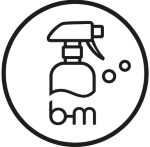
Marks on walls and doors
What you’ll need
- Bicarbonate of Soda
- Magic Sponge, Sponge or Microfibre Cloth
- Warm water
- Rubber gloves
Method
- Sprinkle some Bicarbonate of Soda on a damp Magic Sponge or Microfibre Cloth.
- Gently rub the stained part of the wall in circular motions. The marks will easily come off.
- Dry and remove residue with a clean Microfibre Cloth.
Use for:
Removing stains or crayon marks from walls and doors.

Glass:
Despite being a mild abrasive cleaner, Bicarbonate of Soda has the potential to scratch glass and mirrors, so it‘s best to avoid using it on these surfaces.

Aluminium:
When using Bicarbonate of Soda to clean aluminium surfaces like pans, it can cause oxidisation over time, which turns the surface brown. If you must use Bicarbonate of Soda on aluminium pots and pans, make sure to rinse them immediately after.

Natural Stone:
Avoid using Bicarbonate of Soda on natural stone surfaces like quartz, marble, and granite. Repeated use can damage the sealant and leave scratches on the stone.

Sealed Wood::
Bicarbonate of Soda can damage or wear away the finish or sealant on wood furniture, leaving a dull appearance, so it‘s best to avoid using it on wooden surfaces.

Antique Silver:
While Bicarbonate of Soda can quickly remove tarnish from silverware, it‘s too abrasive and can cause it to lose its patina and tarnish more quickly over time.

Gold-Plated Items::
Gold is a soft metal, so using Bicarbonate of Soda to clean gold-plated utensils or dishes can scratch and ruin the finish. Prolonged use can cause the plating to wear off, so it‘s best to avoid using Bicarbonate of Soda on these items.
Store Bicarbonate of Soda sealed tightly, in a cool, dry place, out of reach of children and pets.
While Bicarbonate of Soda is generally considered a very safe cleaning agent, it is always a good idea to wear rubber gloves if you have highly sensitive skin to prevent dryness. Alternatively, rinse your hands thoroughly after use and avoid contact with your eyes as it can cause redness.
